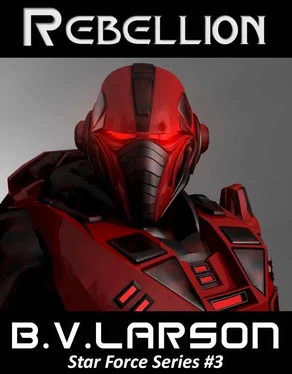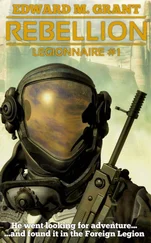B. Larson - Rebellion
Здесь есть возможность читать онлайн «B. Larson - Rebellion» весь текст электронной книги совершенно бесплатно (целиком полную версию без сокращений). В некоторых случаях можно слушать аудио, скачать через торрент в формате fb2 и присутствует краткое содержание. Жанр: Космическая фантастика, на английском языке. Описание произведения, (предисловие) а так же отзывы посетителей доступны на портале библиотеки ЛибКат.
- Название:Rebellion
- Автор:
- Жанр:
- Год:неизвестен
- ISBN:нет данных
- Рейтинг книги:4 / 5. Голосов: 1
-
Избранное:Добавить в избранное
- Отзывы:
-
Ваша оценка:
- 80
- 1
- 2
- 3
- 4
- 5
Rebellion: краткое содержание, описание и аннотация
Предлагаем к чтению аннотацию, описание, краткое содержание или предисловие (зависит от того, что написал сам автор книги «Rebellion»). Если вы не нашли необходимую информацию о книге — напишите в комментариях, мы постараемся отыскать её.
Rebellion — читать онлайн бесплатно полную книгу (весь текст) целиком
Ниже представлен текст книги, разбитый по страницам. Система сохранения места последней прочитанной страницы, позволяет с удобством читать онлайн бесплатно книгу «Rebellion», без необходимости каждый раз заново искать на чём Вы остановились. Поставьте закладку, и сможете в любой момент перейти на страницу, на которой закончили чтение.
Интервал:
Закладка:
Gorski and I worked in a fever. We were able to fluidly create anything our imaginations could come up with. In the end, when our creations stood up and moved — well, it was exhilarating. We carefully reviewed the design and made finishing touches together. We felt certain we had done the best we could with the knowledge we had. The only problem was it was impossible to come up with the perfect design without better intel on what we would be facing.
“I got the feeling after talking to the Macros for a while that they really didn’t know what we were going up against,” I said.
“Maybe they’ve attacked this star system before, and gotten their butts kicked,” Gorski suggested.
“Maybe. What I did get out of them is the stations are in fixed orbits, so our relative velocities shouldn’t be too huge. I got the feeling that they weren’t too well-armed, either.”
“I hope they aren’t,” Gorski said. “I don’t see how this small force could do much if they are strongly defended.”
“I’m sure the Macros have taken that into account,” I lied smoothly. I reflected that I’d gotten better at lying to my subordinates to keep their morale up. Internally, I figured the odds were good this was an insane suicide mission. After all, hadn’t they thrown their own ships at Earth at times, heedless of our defenses? The only time they’d hesitated was when they had their massed fleets. Then, they’d known the penalty for failure would be high, and they’d blinked. That was the weak moment that had allowed me to negotiate the peace agreement between Earth and the machines.
Pushing negative thoughts out of my head, I found I still didn’t like some of the assumptions we had to make while building these assault ships. I’d tried to get as much out of the Macros as I could over the last day or so during a number of short sessions with Macro Command. I’d asked about the exact count of the enemy targets, the size, relative velocity and armament. I hadn’t gotten much. There would be somewhere around ten to one hundred target space stations. There may, or may not be enemy ships defending them. The stations may or may not have defensive weaponry. It was hopeless.
We went back to work fine tuning the propulsion systems. They were critical elements. If they didn’t have enough power we might take days to reach the enemy target and be sitting ducks in space. Or, we might be going too fast relative to our target at the moment of launch and be unable to brake down to a reasonable speed before running into the enemy.
We struggled with the problem of predicting relative velocities. What would we do if we had to slow down to invade an enemy structure, not speed up? In space, if a ship was flying toward an enemy station and you wanted to dock with it-or in this case, invade it-you had to slow down your approach at the end, rather than continuing to accelerate. When they fired us out of this invasion ship, we would already be moving at the same speed as the ship that had launched us, just like an object tossed out of a car window on a highway. If the attacking ship was moving toward the target at say, 50,000 knots, then an assault ship launched from it was going to hit a stationary target at 50,000 knots, even without using its engines at all. At that point, our ships would effectively be missiles, not an invasion force. Missiles with soft payloads of dead marines.
If we encountered this situation, the assault ships would have to brake hard, using their engines to slow down to a speed that would allow a safe landing on the surface of the target.
“In the worst case,” Gorski said as we reviewed our latest design, “I figure we could turn the main repellers around a hundred and eighty degrees and use the main unit for braking if necessary.”
“Maybe we should make a single large propulsion unit, and make it mobile,” I said. “We could forget about all the smaller repellers, and use only one unit for maximum power. That way, we could direct it at any angle and get maximum thrust for braking once we are in close.”
Gorski sucked in air between his teeth, making a hissing sound. He did that a lot, and it was irritating, but I didn’t complain. Most programmers were irritating people, and I included myself in that category. You had to ignore minor oddball habits to get good work out of your dev team. I once knew a guy who had to snap himself with rubber bands to work effectively. Snap, snap, snap. No one wanted to work near his cubicle, but if you let him snap himself until his skin was red, he would produce code that worked every time.
“How about three propulsion units?” Gorski negotiated at last when he was done sucking his teeth. “One big one for thrust, then two smaller ones that rotate around the center for directional control.”
“Why not just one?”
He shook his head. “Because it will take too long to reposition. If they need to avoid an incoming missile or make fine adjustments when making their final approach, a single large unit couldn’t realign fast enough.”
I nodded and agreed with his plan. We would go with three repellers for the assault ships. Once we had the design set, we set our surviving factories to build the needed components. If we had time after the first eight were perfect, we would build more. Next, we gave the nanite hulls their shaping instructions. It was like molding clay. I ran my gloves over the hulls, shaping it and guiding it into the shape I wanted. It was easier to do it that way than to explain to some dull-witted brainbox what you wanted in English. Once you had the nanite walls shaped, you could just tell them to remember the shape and they could reconfigure into that form perfectly. Smart metal was a wonderful thing.
I climbed inside the first assault ship. It was sleek, and I felt a certain sense of pride in the design. Gorski felt it too, and followed me into the interior. The ship was designed with two rows of seats facing one another. Nanite arms were all I needed for harnesses. With a single, shaped-metal chair for the pilot up front and the big laser, the generator and the engine in back, the shuttle was straightforward in purpose and design. All it needed was a pilot and a platoon of marines in the seats, and we were in business.
“Push that wall out, and smooth every surface with a gentle curve,” I told him.
“To provide structural integrity?” he asked.
I shook my head. “If we take a hard hit in one of these things, the men are all dead anyway, but I don’t want them smashing into hard edges if the ride gets bumpy. Even if everything goes perfectly, they are likely to slam their helmets into these walls when they impact with the target. Let’s not give them anything to injure themselves on.”
There was a central rib that pressed into the hull like a belt around the entire ship. This was the track the directional repeller would move along. I took time with my gloved hands to guide the nanites over it, covering it with glittering particles. I felt like a sculptor. I supposed, in a way, that’s what I was.
When we were finally satisfied with the design, we only had room for twenty marines in each ship. That meant a total force of one hundred and sixty marines in eight assault ships. It sounded like an absurdly small force, but I had to remind myself these were not the only men I had going out there. In fact, these few might be the lucky ones. Most of my troops would not be this well-protected. They would be going solo in a cloud behind these assault ships.
The second day we spent designing the solo capsules. They amounted to a bullet-shaped cocoon of nanites wrapped around each marine. A flat disk under each man’s feet was a repeller, his only means of propulsion. Gorski and I designed these in less than an hour and set the factories to churning out the only elements we needed more of: the disk-shaped mini-repellers and a tiny brainbox for each to control it.
Читать дальшеИнтервал:
Закладка:
Похожие книги на «Rebellion»
Представляем Вашему вниманию похожие книги на «Rebellion» списком для выбора. Мы отобрали схожую по названию и смыслу литературу в надежде предоставить читателям больше вариантов отыскать новые, интересные, ещё непрочитанные произведения.
Обсуждение, отзывы о книге «Rebellion» и просто собственные мнения читателей. Оставьте ваши комментарии, напишите, что Вы думаете о произведении, его смысле или главных героях. Укажите что конкретно понравилось, а что нет, и почему Вы так считаете.












